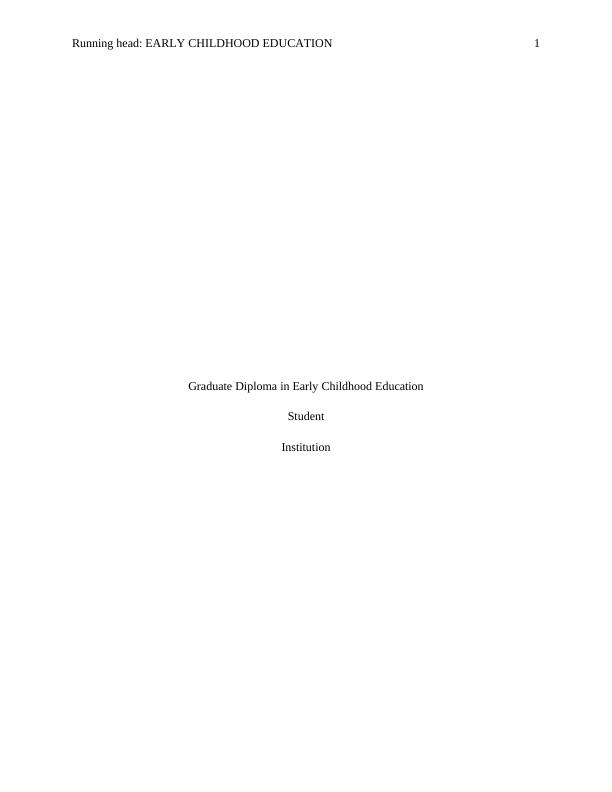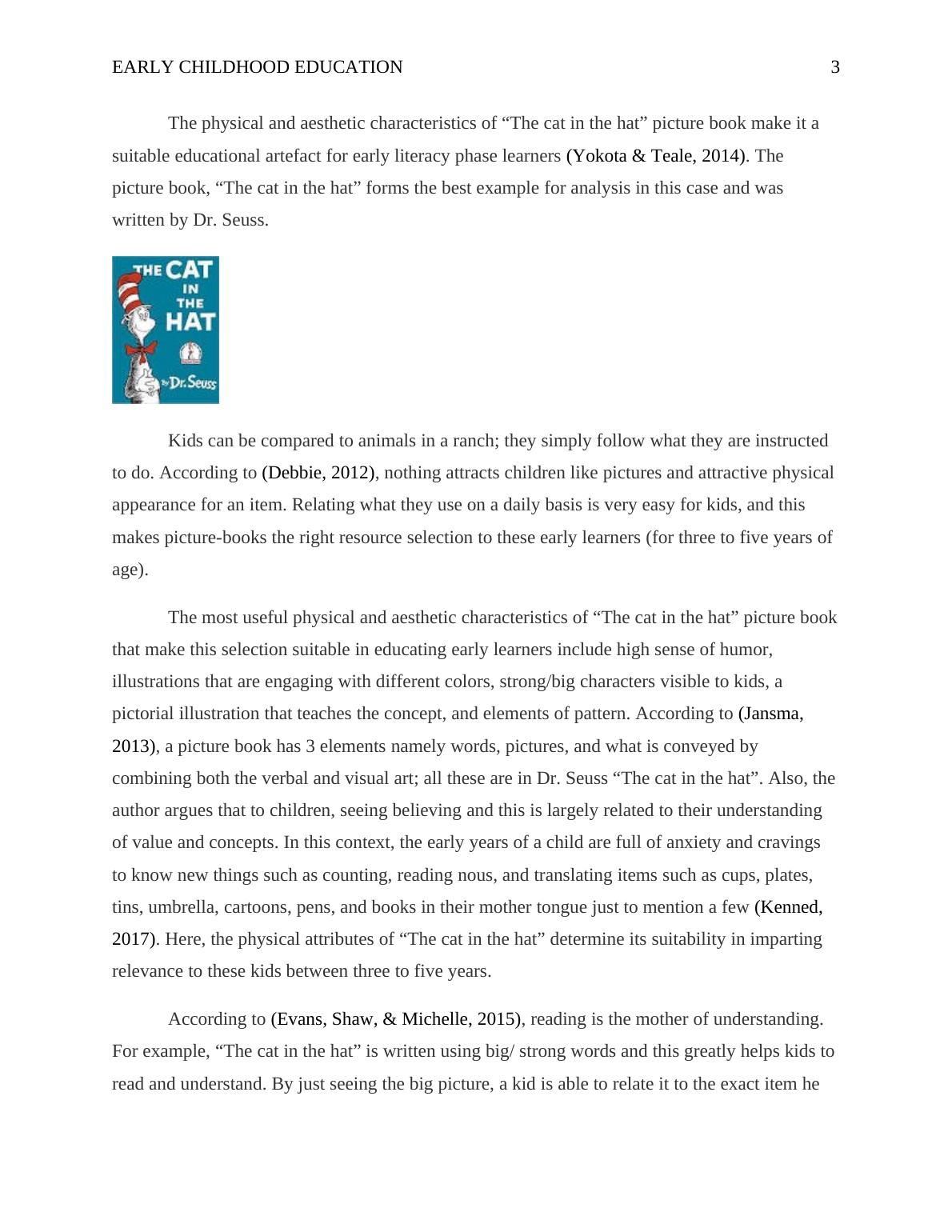The Cat in the Hat: A Suitable Educational Artefact for Early Childhood Education
Added on 2022-10-10
7 Pages2414 Words384 Views
Running head: EARLY CHILDHOOD EDUCATION 1
Graduate Diploma in Early Childhood Education
Student
Institution
Graduate Diploma in Early Childhood Education
Student
Institution

EARLY CHILDHOOD EDUCATION 2
Introduction
Early literacy equips kids with skills of getting ready to learn. While early literacy is
important, not all resources or methods fit here. Early childhood educators have to be choosy and
critical of the quality of resources they use for children’s language and literacy development
(Currues, 2014). In their early ages, these kids increasingly become aware of the language and
literacy skills their educators and parents use and begin to use it. Talking, reading, singing,
dancing, storytelling, and playing games with them are the surest resources that educators can
embrace to build these children’s understanding of language (Kenned, 2017). In Dr. Seuss’
“The cat in the hat”, an eccentric stranger (a cat) enters a house of two kids (Sally and Sam) and
finds them playing in a dull day. The mother of Sam and Sally is not in the house, and
immediately the Cat enters the house, he reassures the kids their mother will accept his tricks.
The outer cover of the book has a cat in form a cartoon, smiling. In early childhood education,
“The cat in the hat” picture book will be suitable to teaching kids how to learn, read and write,
play together/ socialize, and have fun with each other. In particular, the essay will focus on Dr.
Seuss’ “The cat in the hat” picture book which as 61 pages.
How physical and aesthetic characteristics of your resource make it a suitable educational
artefact
I have always liked to interact with kids aged between three to five years. In this
interaction, these children love fun, jokes, and imitating what mature people do. As a student, I
have always been reading story books, novels, and other newsletters that relate to my profession.
My niece in particular, aged 4 years liked to copy what I was doing and would at all times have a
pencil and a book trying to do exactly what I am doing. To me, the interest of this child is to
learn new things and be informed a passion that provokes him even at this early age (Currues,
2014). Not only my niece, I have observed children in baby class who crave to understand the
names of different things by a view of their pictures. The other thing I have observed with baby
class kids is their passion to learn how to handle and make use of books in order to gain
knowledge. These are the main reasons why I chose “The cat in the hat” picture-book as the
educational resource that early childhood educators should select as far as imparting children
with language and literacy skills development is concerned.
Introduction
Early literacy equips kids with skills of getting ready to learn. While early literacy is
important, not all resources or methods fit here. Early childhood educators have to be choosy and
critical of the quality of resources they use for children’s language and literacy development
(Currues, 2014). In their early ages, these kids increasingly become aware of the language and
literacy skills their educators and parents use and begin to use it. Talking, reading, singing,
dancing, storytelling, and playing games with them are the surest resources that educators can
embrace to build these children’s understanding of language (Kenned, 2017). In Dr. Seuss’
“The cat in the hat”, an eccentric stranger (a cat) enters a house of two kids (Sally and Sam) and
finds them playing in a dull day. The mother of Sam and Sally is not in the house, and
immediately the Cat enters the house, he reassures the kids their mother will accept his tricks.
The outer cover of the book has a cat in form a cartoon, smiling. In early childhood education,
“The cat in the hat” picture book will be suitable to teaching kids how to learn, read and write,
play together/ socialize, and have fun with each other. In particular, the essay will focus on Dr.
Seuss’ “The cat in the hat” picture book which as 61 pages.
How physical and aesthetic characteristics of your resource make it a suitable educational
artefact
I have always liked to interact with kids aged between three to five years. In this
interaction, these children love fun, jokes, and imitating what mature people do. As a student, I
have always been reading story books, novels, and other newsletters that relate to my profession.
My niece in particular, aged 4 years liked to copy what I was doing and would at all times have a
pencil and a book trying to do exactly what I am doing. To me, the interest of this child is to
learn new things and be informed a passion that provokes him even at this early age (Currues,
2014). Not only my niece, I have observed children in baby class who crave to understand the
names of different things by a view of their pictures. The other thing I have observed with baby
class kids is their passion to learn how to handle and make use of books in order to gain
knowledge. These are the main reasons why I chose “The cat in the hat” picture-book as the
educational resource that early childhood educators should select as far as imparting children
with language and literacy skills development is concerned.

EARLY CHILDHOOD EDUCATION 3
The physical and aesthetic characteristics of “The cat in the hat” picture book make it a
suitable educational artefact for early literacy phase learners (Yokota & Teale, 2014). The
picture book, “The cat in the hat” forms the best example for analysis in this case and was
written by Dr. Seuss.
Kids can be compared to animals in a ranch; they simply follow what they are instructed
to do. According to (Debbie, 2012), nothing attracts children like pictures and attractive
physical appearance for an item. Relating what they use on a daily basis is very easy for kids,
and this makes picture-books the right resource selection to these early learners (for three to five
years of age).
The most useful physical and aesthetic characteristics of “The cat in the hat” picture book
that make this selection suitable in educating early learners include high sense of humor,
illustrations that are engaging with different colors, strong/big characters visible to kids, a
pictorial illustration that teaches the concept, and elements of pattern. According to (Jansma,
2013), a picture book has 3 elements namely words, pictures, and what is conveyed by
combining both the verbal and visual art; all these are in Dr. Seuss “The cat in the hat”. Also, the
author argues that to children, seeing believing and this is largely related to their understanding
of value and concepts. In this context, the early years of a child are full of anxiety and cravings
to know new things such as counting, reading nous, and translating items such as cups, plates,
tins, umbrella, cartoons, pens, and books in their mother tongue just to mention a few (Kenned,
2017). Here, the physical attributes of “The cat in the hat” determine its suitability in imparting
relevance to these kids between three to five years.
According to (Evans, Shaw, & Michelle, 2015), reading is the mother of
understanding. For example, “The cat in the hat” is written using big/ strong words and this
greatly helps kids to read and understand. By just seeing the big picture, a kid is able to relate it
The physical and aesthetic characteristics of “The cat in the hat” picture book make it a
suitable educational artefact for early literacy phase learners (Yokota & Teale, 2014). The
picture book, “The cat in the hat” forms the best example for analysis in this case and was
written by Dr. Seuss.
Kids can be compared to animals in a ranch; they simply follow what they are instructed
to do. According to (Debbie, 2012), nothing attracts children like pictures and attractive
physical appearance for an item. Relating what they use on a daily basis is very easy for kids,
and this makes picture-books the right resource selection to these early learners (for three to five
years of age).
The most useful physical and aesthetic characteristics of “The cat in the hat” picture book
that make this selection suitable in educating early learners include high sense of humor,
illustrations that are engaging with different colors, strong/big characters visible to kids, a
pictorial illustration that teaches the concept, and elements of pattern. According to (Jansma,
2013), a picture book has 3 elements namely words, pictures, and what is conveyed by
combining both the verbal and visual art; all these are in Dr. Seuss “The cat in the hat”. Also, the
author argues that to children, seeing believing and this is largely related to their understanding
of value and concepts. In this context, the early years of a child are full of anxiety and cravings
to know new things such as counting, reading nous, and translating items such as cups, plates,
tins, umbrella, cartoons, pens, and books in their mother tongue just to mention a few (Kenned,
2017). Here, the physical attributes of “The cat in the hat” determine its suitability in imparting
relevance to these kids between three to five years.
According to (Evans, Shaw, & Michelle, 2015), reading is the mother of
understanding. For example, “The cat in the hat” is written using big/ strong words and this
greatly helps kids to read and understand. By just seeing the big picture, a kid is able to relate it

End of preview
Want to access all the pages? Upload your documents or become a member.
Related Documents
Language and Literacies in Early Childhood Assignment 2022lg...
|9
|2303
|37
Early Childhood Educators: Resources for Language and Literary Developmentlg...
|7
|1781
|372
Teaching Resources for Early Childhood Education: Literacy and Communication Developmentlg...
|12
|2850
|169
